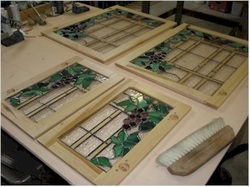How To Install Stained Glass In A Cabinet Door
We get requests for instructions on how to install glass quite often. It sometimes presents us with a dilemma, because as you're doing an install, it's often difficult to stop and take pictures. We recently installed a number of panels in cabinet doors which gave us a chance to document the process.

Start by checking that the glass fits in the opening. You don't want to lay the glass down in silicone and then find out the glass doesn't fit. Lay out the tools you'll need, silicone caulk (or paintable caulk if the application calls for it), a roll of toilet paper and a nearby trash can to get rid of the unwanted caulk.
(Cabinet doors usually get silicone caulk because of it's flexibility, most other installs get paintable caulking because it's less messy.)
(Cabinet doors usually get silicone caulk because of it's flexibility, most other installs get paintable caulking because it's less messy.)

To begin the installation, lay down a bead of caulking, about 1/8" wide, all around the inside of the frame. Keep the gun aimed so that the bead fills right in the corner of the edge of the opening.

With the caulking in place, guide the glass into the opening, allowing the glass to sit into the silicone without disrupting it too much. You want it to stay where it is and you want to avoid squeezing it out into areas you don't want it.

Gently ease the other side of the panel into place and center it in the opening.

Now lay a bead of silicone on top of the glass, filling the gap between the glass and the door edge.

Once the bead is laid on top of the glass, you'll want to smooth it out. This is a great time to use your fingers, but use care and caution because you don't want to get silicone all over the woodwork or the glass. Try to drag as little of the silicone bead away, while leaving a smooth edge behind you.

Use care to get very little silicone on the glass, making the caulking bead as smooth as possible. And keep toilet paper handy to wipe excess caulk off of your fingers. Keeping your hands clean will help keep the glass clean.

Sometimes, as you are smoothing a bead, you may switch fingers, keeping the smoothing process flowing along "smoothly." Just make sure to clean all finger tips off on the toilet paper when you get to a stopping place. Use as much as you need, don't try to skimp on the paper, silicone is sticky and your install can become a beast if you get it in unwanted places.

After you get the panels siliconed in place, let them cure for 24 hours before crating them for shipment. If there are any places where you got silicone in an unwanted area, let it cure before lightly scraping it off with a razor blade. Trying to clean things up while caulking is wet usually ends in making the problem worse.
Here some of the cabinet doors are, installed and adding an elegant touch to the kitchen. They add beauty to the home and add to the appraised value as well.



